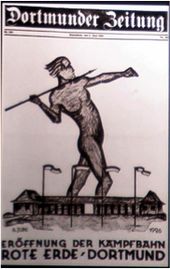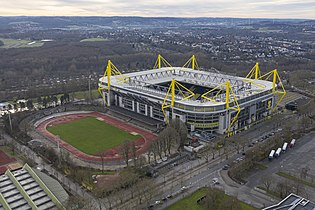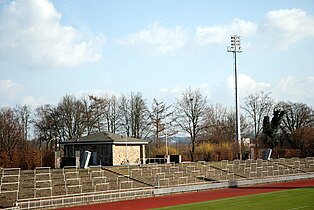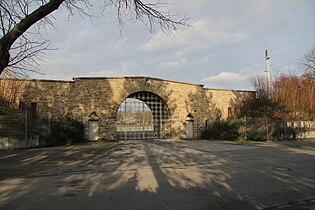Red Earth Stadium
| Red Earth Stadium | |
|---|---|

|
|
| Aerial view of the Rote Erde stadium | |
| Data | |
| place |
|
| Coordinates | 51 ° 29 '33 " N , 7 ° 27' 16" E |
| owner | City of Dortmund |
| start of building | 1924 |
| opening | June 6, 1926 |
| First game | City selection Dortmund - FC Wacker Munich 1:11 |
| Renovations | 1976, 2008 |
| surface | Natural grass |
| architect | Hans Strobel |
| capacity | 25,000 / 9,999 in the Regionalliga West |
| Societies) | |
|
|
| Events | |
|
|
The Rote Erde stadium , formerly known as the Rote Erde arena, was built in 1926 in Dortmund in the immediate vicinity of the Westfalenhallen on Strobelallee . Since the construction of the Westfalenstadion , it has been directly adjacent to its east stand.
history
The construction of the stadium between 1924 and 1926 was mainly carried out by unemployed people as part of emergency work. The stadium was opened with two events: on June 6, 1926, the bourgeois athletes opened the arena, a week later an event for the workers' gymnast took place.
On September 4, 1927, the German Catholic Day took place in the stadium and in the adjacent Westfalenhalle . This event was organized by the Pope's Apostolic Nuncio in Germany, Eugenio Pacelli , who later became Pius XII. Pope was headed.
In 1929 the quarter-final match for the German soccer championship 1928/29 between FC Schalke 04 and Hertha BSC was played in the stadium. Hertha from Berlin won the game with 4-1 goals.
In 1932 the arena was the venue for the Reich Meeting of the German Youth Force and the Reich Warrior Day .
After its opening, it was the home of Borussia Dortmund from 1937 until the opening of the Westfalenstadion in 1974 . In the meantime, in the 1960s, the "arena" had a capacity of 42,000 spectators due to an additional wooden standing grandstand. This additional capacity was important for BVB's games due to the often high level of audience interest. The stadium was badly damaged in the bombing raids on Dortmund during World War II . In the post-war years, the war damage was repaired and Borussia Dortmund celebrated great success here in the 1950s and 1960s.
The makeshift stand made of wood and the roof were transported to Hanover after the opening of the Westfalenstadion . The roof is now part of the grandstand of the Rudolf Kalweit Stadium of SV Arminia Hannover , the grandstand is in the Oststadtstadion of OSV Hannover , where it was badly damaged by fire in March 2010.
Two international football matches for the German national football team took place in the Rote Erde stadium:
- May 8, 1935: German Empire - Irish Free State 3: 1


- April 8, 1967: Germany - Albania 6: 0 ( EM 1968 - Qualification )


In the 1950s, the Rote Erde stadium was the venue for boxing events several times. Between 1950 and 1955, six boxing events with a total of over 200,000 spectators took place here. The European championship fight between Heinz Neuhaus and Hein ten Hoff on July 20, 1952, which ended with a knockout victory for Neuhaus in the first round, was legendary .
In 1990 the Rote Erde stadium hosted the German Gymnastics Festival .
Today it is an athletics stadium with a capacity of 25,000 spectators, with 3,000 covered seats and 7,000 standing places. It serves Dortmund clubs such as LG Olympia Dortmund , LAC Dortmund , LC Rapid Dortmund and TuS Westfalia Hombruch as a training and competition facility. It is also used as a venue by the second men's team from Borussia Dortmund ; then 9,999 spectators are admitted, of which 3,000 are seated.
The stadium is registered as an architectural monument in the list of monuments of the city of Dortmund . In December 2008, after a 14-month construction period, a fundamental renovation of the stadium was completed. A concrete and fire protection renovation was carried out for 1.65 million euros.
In the 2009/10 season, when Borussia Dortmund's second team played in the third division , the Rote Erde stadium served as the team's venue, although it did not meet the requirements of the DFB . The regulations for the 3rd league stipulate a light intensity of 800 lux , but the floodlight system of the stadium only provides a light intensity of 586 lux. Nevertheless, after the second team of Borussia Dortmund rose again, the stadium was also a venue in League 3 between 2013 and 2015 .
gallery
literature
- Hans Strobel: The Dortmund arena "Rote Erde". In: Bauwelt. Journal for the entire construction industry. Issue 33, 1926.
Web links
- Description of this sight on the route of industrial culture
- behrenberg.de: Private homepage with further photos of the stadium
- martijnmureau.nl: History and photos of the Rote Erde stadium
- groundhopping.de: Visitor report from 2004
Individual evidence
- ↑ groundhopping.de: Visitor report from 2005
- ^ Stadion Rote Erde ( Memento from July 19, 2011 in the Internet Archive )
- ↑ martijnmureau.nl: History and photos of the Rote Erde stadium
- ^ HAZ (March 22, 2010): Tribune of the OSV Hanover catches fire
- ↑ http://www.radio912.de/infos/dortmund/nachrichten/art749,378918
- ↑ liga3-online.de : venue data for the Rote Erde stadium.
- ↑ No. A 0022. List of monuments of the city of Dortmund. (PDF) In: dortmund.de - The Dortmund city portal. Monument Authority of the City of Dortmund, April 14, 2014, archived from the original on September 15, 2014 ; accessed on June 12, 2014 (size: 180 kB).
- ↑ Ruhr-Nachrichten (December 12, 2008): Rote Erde Stadium has been completely renovated






